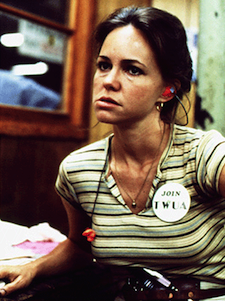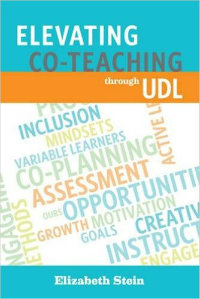Standing Up for Our Students in the New Year
A MiddleWeb Blog
 Co-teachers, it’s time to take a stance – a strong, visible and audible projection of what you believe in.
Co-teachers, it’s time to take a stance – a strong, visible and audible projection of what you believe in.
It’s the perfect time of year to create a resolution to advocate for that one student or that group of students who have been on your mind every day since school began.
You know the situation I am talking about – it’s the one that you wish you could change. It’s the one that’s kept you thinking since September: “…if only….then I could….”
Commit to a resolution to make that “if only” happen in 2017! Let’s begin by considering some background on why co-teachers need to be social justice leaders.
Social justice for positive change
Simply put, being mindful of social justice is about creating positive change for others within a society. Social justice leaders notice oppression, biases, prejudice, and/or inequality and say, this just isn’t right! And then they stand up and do something.
Cobb and Sharma (2015) believe that learning opportunities informed by social justice must be a part of the educational experience. Approaching some lessons through a social justice lens, educators create the opportunities for students to develop the critical awareness needed to partake in ethical thinking and social actions that produce positive change.
How ableism oppresses
Ableism is one example of oppression that is particularly prevalent within inclusive settings. I have seen it be that silent force that unintentionally creates unnecessary barriers. “Ableist” views can rear their ugly heads in a number of ways, whenever:
- Students with disabilities are expected to do things the same way as their nondisabled peers.
- Students with disabilities are viewed as having deficits that must be “fixed” so they can catch up to everyone else.
- Students with disabilities are seen and treated as dependent, in need of adults and able-bodied peers to remediate and compensate for deficits.
- Students with disabilities are the victims of pity and unintentional attitudinal barriers – creating personal belief systems that could easily debilitate them for a lifetime.

Pushing back against ableism
This could be the year where you do your part to confront ableism. The first step in confronting it is noticing that it exists around you every day. Co-teachers must notice the way they include students within the learning process. Here are some tips for banishing any unintentional ableist views.
Make sure to:
- Incorporate flexible heterogeneous groups.
- Rotate student leadership opportunities – where each learner has the opportunity to share and/or lead his or her peers in learning something new.
- Watch your own language – be intentional, sensitive, and empowering. Students need to know that you believe in their abilities. We are all a work in progress along a lifetime of learning.
- Focus on students’ strengths. We are all too familiar with the areas we need to improve upon – let’s embrace them! Celebrate our awareness! Move forward with a clear focus on strengths so they could serve to guide our abilities to improve.
In Pedagogy of the Oppressed, activist, educator and philosopher Paulo Freire shared his views that students need to be engaged in consciousness-raising problem solving – opportunities that can be found by engaging with contemporary social issues (2000). (It’s an amazing read. I highly recommend it!)
Including students in creating social justice
In order to advance the level of consciousness around co-creating a sense of justice and ethics, learners need to be a part of a learning community within our classrooms, our schools, towns, cities…and global communities.
Participating within a genuine classroom learning community promotes a solutions-thinking approach in creating equitable educational experiences. Here’s what it could look like in any classroom:
- Teachers and students co-create a community of learners within the classroom where each voice is valued.
- Teachers encourage a social justice lens by creating the space for students to discuss, interact, and think deeply to support social justice in their social interactions.
- Teachers encourage dialogue with and between learners and facilitate problem-posing experiences that work to broaden perspectives and address issues in schools and society.
Let’s return to your thinking at the beginning of this post. Consider that one student – or group – who tugs on your social justice leader heartstrings. Perhaps your thinking has evolved a bit, and you are now thinking of another student or situation that just screams, “Help find a solution here!”
So what can you do about it? How can you make a difference and create positive change? Who can you collaborate with? What resources could you seek to direct your vision and action steps? Share your ideas, questions, and experiences below in the comment section.
In the meantime, in addition to the resources shared above, here are some more resources to get you started:

2.Creating Classrooms for Social Justice by Dr. Tabitha Dell’Angelo at the one and only Edutopia.
3. And here’s a reminder to get the social leader juices flowing! Be sure to read and/or reread Co-Teachers! Are you Willing to be Disturbed?
So what’s on your mind? Let’s get all Norma Rae and take a social justice stance together – right now. It all starts with sharing your voice here…




































Elizabeth,
You’ve written a powerful and important blog post. We are indeed “Norma Raes” who need to stand up for our students. It is one of the most difficult but necessary differences we can make in the lives of our students, even if we are all alone on that island (or so it can feel that way~very isolating).
A few years back I had the difficult experience of working with a math teacher who truly didn’t like kids who couldn’t keep up with her fast paced class. 85% of her grade was tests/quizzes and the rare project. By Christmas 80% of the kids on IEPs were failing, some with no math disabilities. When I shared my concerns, she shrugged her shoulders and said, “well that doesn’t surprise me.” I wanted to work with her to help the kids (review tests they had failed and give them a second chance); “I don’t do retakes” was the reply. I wanted to provide alternative opportunities for them to demonstrate their knowledge (additional projects, etc). She wouldn’t budge. Sadly, our principal stepped in and it got very ugly. It cost me my health and I asked for a transfer. The only thing that kept me going were those kids; they confided they felt like failures and were afraid they would either repeat 6th grade or have to go to summer school.
There were several who did have to pay $250 to go to summer school so they could be promoted and to this day I feel a sense of heartache for those sweet kids and anger at the situation. I learned several things from this experience, and the most important was to stand up for the kids even if you stand alone. Let the kids know “I have your back.” For some of our students we are are the only ones who do.
PS both the principal and teacher are gone, and I stayed 5 more years and ended up working with one of the most phenomenal math teachers ever.
Laurie, it’s great to have your experiences back in our co-teaching conversations! I’m sure your story sparks some connections as well as some outrage as we all strive to co-create natural inclusive settings.
You bring up such a valuable point–we need to make sure to develop ongoing, meaningful communications with our colleagues and administrators. We all must be on the same page!
And through it all we do all we can for what we believe to be right for kids–no matter what!
Thank you!
Elizabeth,
This is an important post. I found myself nodding my head up and down as I was reading it. If this enables us to speak up for those students who stay in our heads and rip at our hearts, maybe we will be more apt to seek out and find even more students to help. Maybe we will be models for others to start helping others. Dare I say that maybe students will see this and start helping one another??? I believe that these kindnesses are contagious!
Karen, thanks for your comment and enthusiasm–you are spot on! We do what we do with our students in hopes of creating one amazing long-lasting ripple effect!
Thanks for adding your voice and continuing these important conversations!